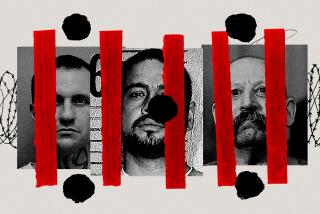Israel Keyes studied serial killers, didn’t want to be called one
- Share via
When Israel Keyes was arrested in Texas in March, detectives flew in from Alaska to question the man suspected of kidnapping an 18-year-old barista in Anchorage.
Anchorage Det. Monique Doll had the ransom note that was sent to Samantha Koenig’s family.
“I put the ransom note in front of him and told him that the first couple of times I had read the note, that whoever had written it was a monster,” Doll told the Los Angeles Times. “And the more I read it, the more I realized that monsters aren’t born, they are created, and this monster had a story to tell.”
He would tell his story eventually. Yes, he had killed Koenig. There were others too -- at least seven more victims.
This week, more details emerged when officials released audio and video footage of Keyes, a 34-year-old construction worker with a side life as a serial killer. In the recordings, he talks about how long he would wait for victims and how one young couple escaped him -- barely -- thanks to police.
Police also revealed that Keyes, who killed himself in jail Dec. 2, had studied serial killer Ted Bundy.
As with Bundy, Keyes’ legacy as a prolific, similarly well-traveled criminal has continued to grow with every detail released by investigators still tracing his deadly path.
Once Keyes was extradited to Alaska, he asked to meet with police again. Detectives arrived with far more evidence this time: photos of Keyes’ truck, of him in a mask making ATM withdrawals with the girl’s stolen debit card. He calmly took it all in, thought about it for a few hours and then spilled to detectives.
“After he told them where he had put the body, and where he had done it, he told us he would be willing to speak of the details … but he would only tell one person, and that was me, and he said to tell me that I had caught my monster,” Doll said.
In the recordings, Keyes discussed other near-killings when he was “out looking for trouble,” sometimes waiting for victims for two or three nights.
“I had a park, a couple parks here in town that I could take my bike to, I had those staked out,” Keyes told detectives, casually, then alluding to a location he had near a rest area at the north fork of Eagle River where he’d stashed a “kill bag” filled with his equipment. “The plan there was, I had that parking lot staked out, waiting for somebody after fairly late.”
Then he yawned before continuing. “I was gonna take them and use the cutoff tool, lock the gate [with a padlock] and do my thing there in the parking lot, and I had the Drano and shovel stocked up there as a way to get rid of the body if I needed it.”
Another time, he’d brought his gun and gotten the drop on a young couple in a park late at night, but he told his interviewers that he hesitated when an Anchorage Police Department officer showed up to tell the couple the park was closed.
“Could have got ugly, but fortunately for the cop guy, he, uh,” -- Keyes chuckles here -- “his backup showed up. APD is really good, all by the book and stuff, and that’s about the time I got a scanner, because I almost got myself in a lot of trouble on that one. ... Almost pulled the trigger almost with him there, and that would have got really ugly, really fast. Yeah, anyway, as soon as his backup showed up, I decided I better call it a night and got back on my bike and took off.”
Keyes’ body of work as a violent criminal was methodical yet unpredictable -- the victims would be random, but his locations would be well-scouted, and he exercised self-control in canceling attacks if the conditions weren’t right.
He was suspected of killing a couple in Vermont, someone else on the East Coast and four more people in Washington state, but never anyone he knew. He also confessed to arson, bank robbery and sexual assault throughout his life.
He studied Bundy but bristled at being compared with anyone else. These are my own ideas, this is my own material, this is my way of doing things, he told detectives. “He didn’t want to be seen as copycatting anyone else,” Doll said.
Keyes, who told his interviewers he received a weekly subscription to the New York Times while in prison, also didn’t want to be seen in the public’s eye as a serial killer.
Officials agreed to keep his case quiet in the hope of eliciting more confessions. He had promised to tell them everything, even at a meeting three days before his death.
“If you recall Ted Bundy, he was kind of the opposite; he reveled in attention,” Doll said. “Israel Keyes was the exact opposite in that way. He very deliberately did not want to be titled a ‘serial killer’ because it would draw attention to him, and it would draw the media down on his loved ones. He was very protective of his friends and family.”
As the Los Angeles Times detailed last weekend, Keyes grew up in a large religious family in the Northwest.
Though Keyes did not appear to show any impulse toward self-protection -- he never tried to use his confessions to get out of a possible death penalty for the Koenig killing -- he nonetheless tried to escape. At an Anchorage court hearing in May in the Koenig case, he leaped over a railing to the spectators’ gallery before he was tasered and captured. “Kill him!” someone shouted during the struggle.
“We talked to him after that and we told him that was really stupid, and he had been cooperating,” said Kelvin Feldis, chief of the criminal division for the U.S. attorney’s office in Alaska. “His reaction was, ‘Even if there was a 1% chance that I was going to get out of there, why not try it.’ ”
Keyes hadn’t planned on being captured in the first place. “He told us he regretted not having killed more, not having done more before he was arrested,” Feldis said. “He never planned on being taken alive. He was going to go down shooting and not come out of it alive if he was ever caught.”
Keyes had been temporarily placed on suicide watch and received treatment while in prison a few months before his death, but state prison officials would not confirm anything more specific.
Keyes finally made his big escape on Dec. 2, when he stripped a blade from a disposable razor, fastened it to a pencil and slit his left wrist; he also wrapped a blanket around his neck and strangled himself. He left pages of crumpled writing behind, but Alaska prison spokeswoman Beth Ipsen said they were covered in too much blood to be legible.
His death, even a week later, even after nine months of investigation, still had some officials coming to grips with a mysterious and disturbing killer. Keyes never got the chance to talk to Doll alone, and she never got the chance to ask him why he wanted to tell her all about how he’d dismembered and hidden Koenig’s body.
“I think -- and I’ll couch this with ‘this is my opinion’ -- I think based on our subsequent contact with him, he kind of wanted to look me in the eye while he told me about Samantha,” Doll said. “I think he wanted to prove me wrong -- to show that monster’s aren’t created, they’re born.”
ALSO:
Hypnosis OKd for sergeant charged in Army clinic killings
Scalia defends comparing laws against homosexuality to murder
‘Buckwild,’ new MTV reality show, draws wrath of W.Va. senator
More to Read
Sign up for Essential California
The most important California stories and recommendations in your inbox every morning.
You may occasionally receive promotional content from the Los Angeles Times.











